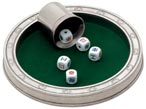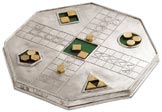The first board games were almost certainly of a religious nature. The oldest one, now at the Musèe du Cinquanténaire in Brussels, dates back to between 4000 and 3500 b.C. It was discovered in a predynastic cemetery at El-Mahasna, eight miles north of Abydos in Upper Egypt, together with a large number of objects in ivory and clay. The archaeologists who discovered the tomb thought that its occupant was a wizard or a fortune teller and that the game helped him to predict the future or was used for divinatory purposes.
The often supernatural aspect of board games derives from the idea that the gods control "fortune" and the outcome of throws of dice. According to the ancient Greeks, Palamedes invented dice as a pastime during the ten-year siege of Troy. But dice are older than the war of Troy. The first dice were probably pieces of wood, broken twigs, with two faces, one rounded face and one flat. They were based on the "heads or tails" system which was complicated by the number of twigs used. The present-day shape, in which the opposing faces always total 7 when added together, dates back to 1400 b.C. .
We have three board games: Ludo, introduced in England in 1896 as a simplification of the Indian game "Pachisi", Pope Joan which originated in England in the early nineteenth century and dice, the origins of which are both very ancient and common to more or less all geographical areas.
The often supernatural aspect of board games derives from the idea that the gods control "fortune" and the outcome of throws of dice. According to the ancient Greeks, Palamedes invented dice as a pastime during the ten-year siege of Troy. But dice are older than the war of Troy. The first dice were probably pieces of wood, broken twigs, with two faces, one rounded face and one flat. They were based on the "heads or tails" system which was complicated by the number of twigs used. The present-day shape, in which the opposing faces always total 7 when added together, dates back to 1400 b.C. .
We have three board games: Ludo, introduced in England in 1896 as a simplification of the Indian game "Pachisi", Pope Joan which originated in England in the early nineteenth century and dice, the origins of which are both very ancient and common to more or less all geographical areas.

|
|
Dice-set boardgame
cm Ø 24 10050 - OUT OF STOCK |



